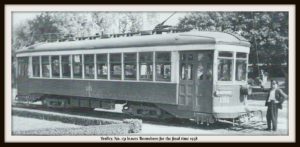Thousands of years ago, what is now Boonsboro’s Main Street was a trail used by Eastern elk, woodland bison, deer and timber wolves as they ranged about the, yet undiscovered, New World. Native Americans would later follow the same route. Since the colonization of America began at Jamestown in 1607, countless explorers and pioneers have passed along that same path, first on foot and on horseback, later with ox wagons and stagecoaches. But for a brief period from 1902 to 1938 the Hagerstown-Frederick Electric Railway Company carried passengers along this ancient route on a trolley that connected Boonsboro with Wagner’s Crossroads, Mapleville, Funkstown, Hagerstown and beyond.
Response to the first excursion of the trolley was so great in August of 1902 that it swamped the trolley with 500 tickets sold. By October, U.S. Mail was being carried on the Hagerstown-Boonsboro line and a regular round trip ticket cost $0.50. And, of course, there were mishaps. Around 1910, a car carrying 15 tons of coal broke loose from its motor car, jumped the tracks and plowed though the dining room of Otto Neikerk’s house in Boonsboro nearly hitting Neikerk’s wife.
The combination of the Great Depression and the ever-increasing availability of the automobile brought an end to this mode of transport. Trolley #151 left Boonsboro for the last time in 1938. This colorful interval of Boonsboro’s history is chronicled in the Boonsboro Trolley Museum, the last remaining trolley station in Washington County. Standing at the intersection of North Main Street and Shafer Park Road, the artfully restored trolley station reminds passers-by of the days before cars ruled the roadways.



